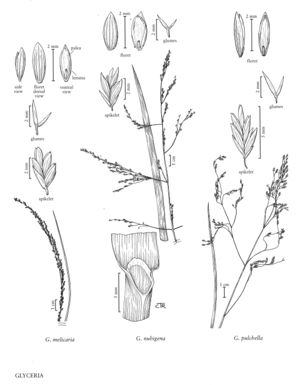Difference between revisions of "Glyceria melicaria"
FNA>Volume Importer |
imported>Volume Importer |
||
| (4 intermediate revisions by 2 users not shown) | |||
| Line 4: | Line 4: | ||
|publications= | |publications= | ||
|common_names=Melic mannagrass;Glycerie melicaire | |common_names=Melic mannagrass;Glycerie melicaire | ||
| + | |special_status={{Treatment/ID/Special_status | ||
| + | |code=E | ||
| + | |label=Endemic | ||
| + | }} | ||
|basionyms= | |basionyms= | ||
|synonyms= | |synonyms= | ||
| Line 17: | Line 21: | ||
-->{{Treatment/Body | -->{{Treatment/Body | ||
|distribution=Maine;Md.;N.J.;Conn.;N.Y.;Miss.;Ohio;N.H.;N.C.;Ala.;N.B.;N.S.;Ont.;Que.;Tenn.;Va.;Pa.;Vt.;W.Va.;Ga.;Mass.;Ky.;R.I. | |distribution=Maine;Md.;N.J.;Conn.;N.Y.;Miss.;Ohio;N.H.;N.C.;Ala.;N.B.;N.S.;Ont.;Que.;Tenn.;Va.;Pa.;Vt.;W.Va.;Ga.;Mass.;Ky.;R.I. | ||
| − | |discussion=<p>Glyceria melicaria grows in swamps and wet soils. Its range extends from southeastern Ontario east to Nova Scotia, south to Illinois and the northeastern United States and, in the Appalachian Mountains, to northern Georgia. Glyceria xgatineauensis Bowden is a sterile hybrid between G. melicaria and G. striata. For further comments, see p. 77.</p> | + | |discussion=<p><i>Glyceria melicaria</i> grows in swamps and wet soils. Its range extends from southeastern Ontario east to Nova Scotia, south to Illinois and the northeastern United States and, in the Appalachian Mountains, to northern Georgia. <i>Glyceria</i> xgatineauensis Bowden is a sterile hybrid between <i>G. melicaria</i> and <i>G. striata</i>. For further comments, see p. 77.</p> |
|tables= | |tables= | ||
|references= | |references= | ||
| Line 26: | Line 30: | ||
-->{{#Taxon: | -->{{#Taxon: | ||
name=Glyceria melicaria | name=Glyceria melicaria | ||
| − | |||
|authority=(Michx.) F.T. Hubb. | |authority=(Michx.) F.T. Hubb. | ||
|rank=species | |rank=species | ||
| Line 34: | Line 37: | ||
|family=Poaceae | |family=Poaceae | ||
|illustrator=Cindy Roché | |illustrator=Cindy Roché | ||
| + | |illustration copyright=Utah State University | ||
|distribution=Maine;Md.;N.J.;Conn.;N.Y.;Miss.;Ohio;N.H.;N.C.;Ala.;N.B.;N.S.;Ont.;Que.;Tenn.;Va.;Pa.;Vt.;W.Va.;Ga.;Mass.;Ky.;R.I. | |distribution=Maine;Md.;N.J.;Conn.;N.Y.;Miss.;Ohio;N.H.;N.C.;Ala.;N.B.;N.S.;Ont.;Que.;Tenn.;Va.;Pa.;Vt.;W.Va.;Ga.;Mass.;Ky.;R.I. | ||
|reference=None | |reference=None | ||
|publication title= | |publication title= | ||
|publication year= | |publication year= | ||
| − | |special status= | + | |special status=Endemic |
| − | |source xml=https:// | + | |source xml=https://bitbucket.org/aafc-mbb/fna-data-curation/src/200273ad09963decb8fc72550212de541d86569d/coarse_grained_fna_xml/V24/V24_85.xml |
|subfamily=Poaceae subfam. Pooideae | |subfamily=Poaceae subfam. Pooideae | ||
|tribe=Poaceae tribe Meliceae | |tribe=Poaceae tribe Meliceae | ||
Latest revision as of 16:25, 11 May 2021
Plants perennial. Culms 50-100 cm tall, 3-5 mm thick, erect. Sheaths smooth, not or only weakly keeled; ligules 0.2-0.9 mm, translucent, rounded to truncate; blades 25-40 cm long, 2-7 mm wide, abaxial surfaces smooth, adaxial surfaces scabridulous. Panicles 15-25 cm long, 0.8-1.5 cm wide, linear, nodding; branches 5-9 cm, appressed, scarcely surpassing the node above, with 30-60+ spikelets; pedicels 0.5-2 mm. Spikelets 3.5-5 mm long, 1-2.5 mm wide, laterally compressed, oval in side view, with 3-4 florets. Glumes lanceolate, veins terminating below the apices, apices acute; lower glumes 1.3-2.4 mm; upper glumes 1.7-3 mm; rachilla internodes 0.4-0.6 mm; lemmas 1.9-2.8 mm, smooth or scabridulous, 5-7-veined, veins raised, apices acute, prow-shaped; paleas slightly shorter to slightly longer than the lemmas, lengths 2.5-4 times widths, keels well developed, not winged, tips incurved, narrowly notched between the keels; anthers 2, 0.3-0.5 mm. Caryopses 1-1.5 mm; hila subequal to the caryopses. 2n = 40.
Distribution
Maine, Md., N.J., Conn., N.Y., Miss., Ohio, N.H., N.C., Ala., N.B., N.S., Ont., Que., Tenn., Va., Pa., Vt., W.Va., Ga., Mass., Ky., R.I.
Discussion
Glyceria melicaria grows in swamps and wet soils. Its range extends from southeastern Ontario east to Nova Scotia, south to Illinois and the northeastern United States and, in the Appalachian Mountains, to northern Georgia. Glyceria xgatineauensis Bowden is a sterile hybrid between G. melicaria and G. striata. For further comments, see p. 77.
Selected References
None.
